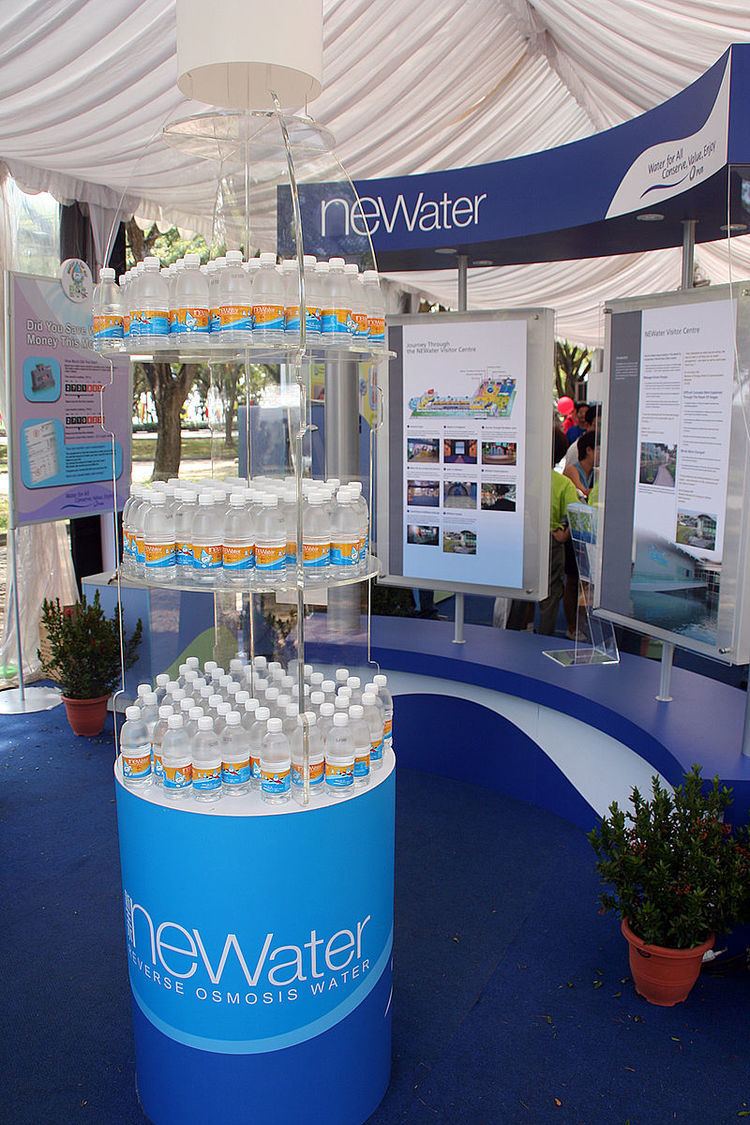 | ||
NEWater is the brand name given to reclaimed water produced by Singapore's Public Utilities Board. More specifically, it is treated wastewater (sewage) that has been purified using dual-membrane (via microfiltration and reverse osmosis) and ultraviolet technologies, in addition to conventional water treatment processes. The water is potable and is consumed by humans, but is mostly used by industries requiring high purity water.
Contents
Production
Singapore currently has four operational NEWater factories, at Bedok, Kranji, Ulu Pandan and Changi. The Bedok and Kranji factories were commissioned in 2002, the Ulu Pandan plant in March 2007 and the Changi plant in August 2009. A plant at Seletar, commissioned in February 2004, is now closed.
The Bedok and Kranji plants are operated by the Public Utilities Board, while the Ulu Pandan and Changi plants are under DBOO concessions by Keppel Seghers and Sembcorp Industries
There is a Visitor Centre in the NEWater factory in Bedok, near the Singapore Expo Tanah Merah MRT Station. The visitor centre was awarded the Best Sightseeing/Leisure/Educational Programme at the 20th Tourism Awards 2005 and the IWA Marketing & Communication Award in 2006.
The visitor centre provides multiple free programmes to educate the public regarding the technologies and production of NEWater:
Process
NEWater is produced by a multiple barrier water reclamation process:
Applications
The total capacity of the plants is about 20 million US gallons per day (75,700 m3/day). Some 6% of this is used for indirect potable use, equal to about 1% of Singapore's potable water requirement of 380 million US gallons per day (13 m3/s). The rest is used at wafer fabrication plants and other non-potable applications in industries in Woodlands, Tampines, Pasir Ris, and Ang Mo Kio.
Potability
The quality of NEWater consistently exceeds the requirements set by USEPA and WHO guidelines and is cleaner than Singapore's other water sources.
Plans are under way to increase the amount of NEWater in indirect potable use up to 3.5% by 2011.
The following table compares the water quality of NEWater to the WHO and USEPA standards.
History
Water recycling in Singapore began in 1974, but the experimental treatment plant was closed a year later because of costs and reliability issues.
In 1998, the Public Utilities Board (PUB) and the Ministry of the Environment and Water Resources (MEWR) initiated the Singapore Water Reclamation Study (NEWater Study). The aim was to determine if NEWater was a viable source of raw water for Singapore's needs. NEWater and desalination both were explored to reduce reliance on water imported from Malaysia, which has long been a source of friction between the Malaysian and Singapore governments. The Malaysian government is treaty bound to sell water to Singapore until 2061, but it has no obligation to do so after that date.
In 2001, PUB initiated efforts to increase water supplies for non-potable use. Using NEWater for these would help reduce the demand on the reservoirs for potable water.
